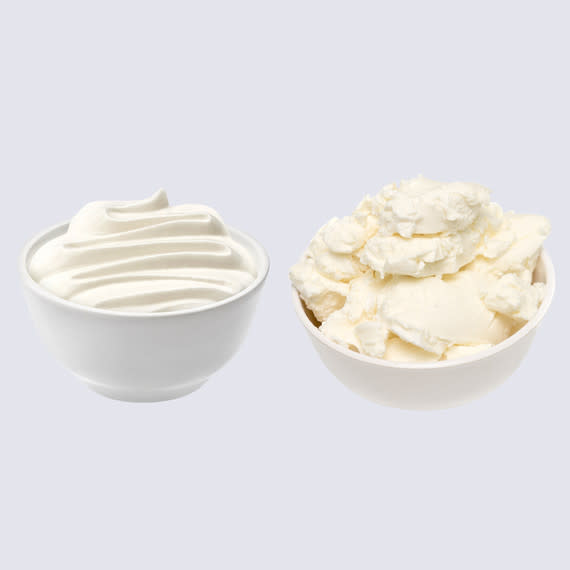What's the Difference Between Créme Fraîche and Sour Cream?

Pass through the dairy aisle and you'll notice creamy cow's milk products that seem similar—crème fraîche, sour cream, yogurt, and mascarpone. What's the difference between these four? Can you substitute them for each other? We chatted with Adeline Druart, president of Vermont Creamery, one of the largest producers of crème fraîche stateside, about all things creamy.
Related: We're Crazy for Crème Fraîche
What Is Crème Fraîche?
Crème fraîche is a rich cultured cream that acts as a thickener in soups, a topping on pasta, as the base of creamy dips, and a delicious dollop of tangy cream on top of sweet desserts. It's made by adding starter cultures to a high fat cream and aging the mixture for several hours. During the aging, the cultures eat up the lactose in the cream; the cultures help the cream to develop body and create a nutty flavor and aroma. At Vermont Creamery, crème fraîche is aged for 20 hours. "The length of culturing causes [the crème fraîche] to have a low pH and low acidity, which makes it stable," says Druart. "Chefs love using crème fraîche because it not only adds great flavor, but it doesn't separate under acid or high heat," Druart says. Most crème fraîche produced in the U.S. has 38-42 percent fat content; in France, 42 percent fat is the standard, and though that's a small percentage it makes a large difference to the flavor and richness of the product, as Druart explains: "The higher fat, the better for cooking."
How Does Sour Cream Compare?
Sour cream is a lightly cultured cream that is required to contain at least 18 percent fat content, per standards set by the Food and Drug Administration. Sour cream ages for about six hours, which creates its characteristic tangy notes but it doesn't have the same depth of nuttiness found in crème fraîche. For a richer flavor, you can substitute crème fraîche in recipes that call for sour cream. However, you'll lose flavor and creaminess if you substitute sour cream for crème fraîche. Unlike yogurt, both crème fraîche and sour cream can be cooked over high heat without risk of curdling or separating.
What's the Deal with Mascarpone?
Mascarpone is a sweet Italian cream cheese. To make mascarpone: "You take high fat cream and fortify it with skim milk or cream powder and cook it at a high temperature. [This creates] a nutty, caramel taste and makes it solidify," says Druart. Mascarpone is not cultured and, with about 48 percent fat content, is creamier than crème fraîche or sour cream. Use mascarpone in tiramisu, sweet rolled cakes, and Butter-Waffle Cookies.
The Bottom Line
While crème fraîche and sour cream serve a similar purpose, which is to add fat and a slight tang to recipes, mascarpone cheese and yogurt are completely different products and should not be used as substitutes for either cream-based product.
